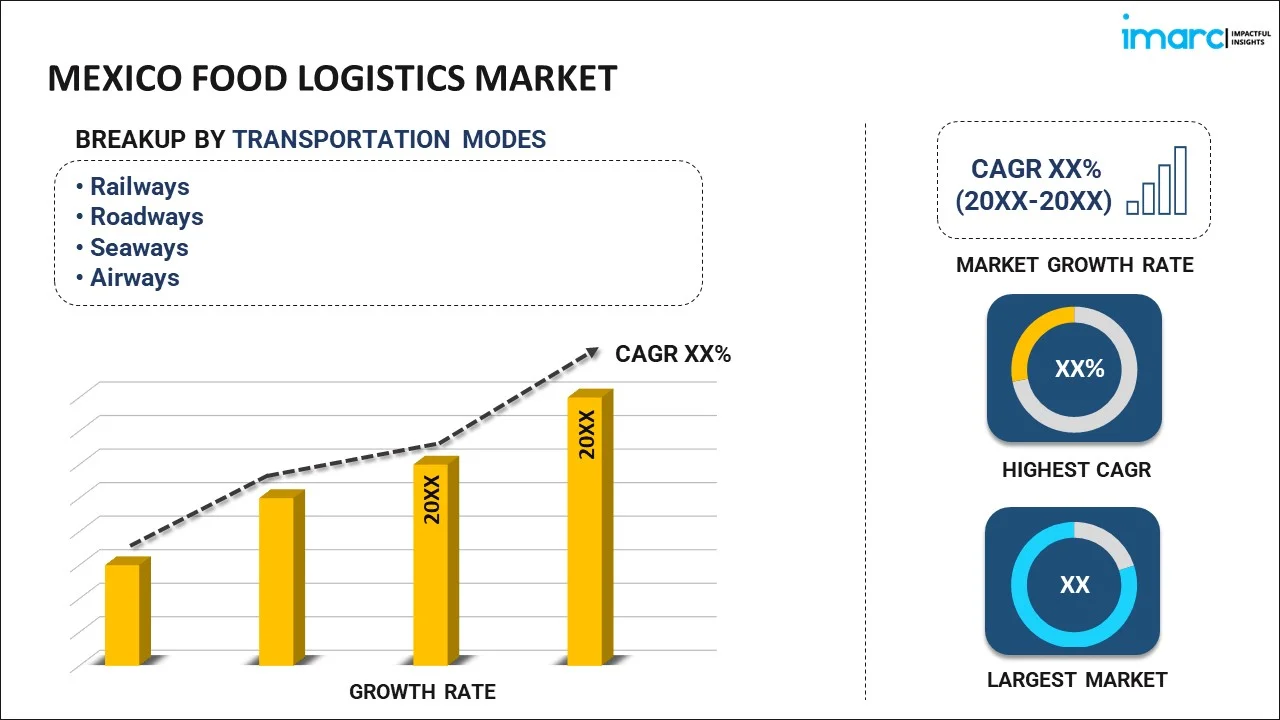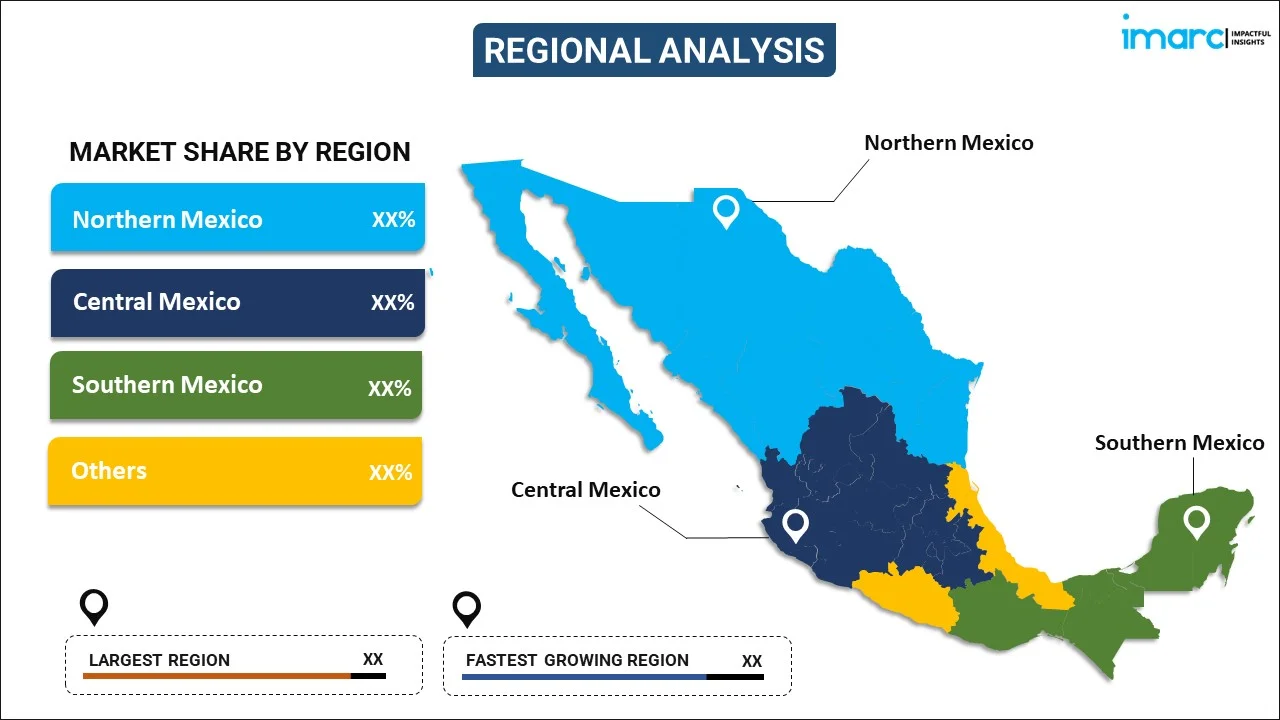
Mexico Food Logistics Market Report by Transportation Mode (Railways, Roadways, Seaways, Airways), Product Type (Fish, Shellfish, and Meat, Vegetables, Fruits, and Nuts, Cereals, Bakery and Dairy Products, Coffee, Tea, and Vegetable Oil, and Others), Service Type (Cold Chain, Non-Cold Chain), Segment (Transportation, Packaging, Instrumentation), and Region 2025-2033
Market Overview:
Mexico food logistics market size reached USD 2.1 Billion in 2024. Looking forward, IMARC Group expects the market to reach USD 4.4 Billion by 2033, exhibiting a growth rate (CAGR) of 8.2% during 2025-2033. The widespread adoption of efficient and reliable solutions to ensure the seamless flow of food products from producers to consumers is primarily driving the market growth across the country.
|
Report Attribute
|
Key Statistics
|
|---|---|
|
Base Year
|
2024 |
|
Forecast Years
|
2025-2033
|
|
Historical Years
|
2019-2024
|
| Market Size in 2024 | USD 2.1 Billion |
| Market Forecast in 2033 | USD 4.4 Billion |
| Market Growth Rate (2025-2033) | 8.2% |
Food logistics involves the systematic and efficient management of the supply chain processes related to the production, transportation, storage, and distribution of food products. This intricate system ensures that food items reach their destinations in a timely and safe manner, from farm to table. It encompasses various stages, including sourcing raw materials, processing, packaging, and delivering finished products to retailers or consumers. Food logistics plays a critical role in maintaining the quality and safety of perishable goods, necessitating precise temperature control and adherence to stringent regulations. With advancements in technology, including tracking systems and real-time monitoring, food logistics aims to minimize waste, reduce costs, and enhance overall supply chain visibility. Efficient food logistics ensures a continuous and reliable flow of products, contributing to the accessibility and availability of diverse food items for consumers across the country.
Mexico Food Logistics Market Trends:
The Mexico food logistics market is witnessing significant growth, driven by several key drivers. Firstly, the increasing demand for diverse food products, both domestically and internationally, is a pivotal factor stimulating the expansion of food logistics services across the country. Besides this, as consumer preferences diversify, the need for efficient supply chain solutions becomes paramount, propelling the market forward. Additionally, the rising number of international trade activities has intensified the complexities of food logistics in Mexico. This has led to an increased emphasis on advanced logistics solutions to ensure the timely and safe delivery of food products across borders. Moreover, the growing integration of technology, such as temperature-controlled transportation and real-time tracking, plays a crucial role in meeting the stringent quality and safety standards of perishable goods. Furthermore, government initiatives and regulatory support contribute to the growth of the food logistics market in Mexico. Apart from this, policies promoting infrastructure development and the adoption of best practices in transportation and storage are fostering a conducive environment for the industry, which in turn, is expected to fuel the market growth over the forecasted period.
Mexico Food Logistics Market Segmentation:
IMARC Group provides an analysis of the key trends in each segment of the market, along with forecasts at the country level for 2025-2033. Our report has categorized the market based on transportation mode, product type, service type, and segment.
Transportation Mode Insights:

- Railways
- Roadways
- Seaways
- Airways
The report has provided a detailed breakup and analysis of the market based on the transportation mode. This includes railways, roadways, seaways, and airways.
Product Type Insights:
- Fish, Shellfish, and Meat
- Vegetables, Fruits, and Nuts
- Cereals, Bakery and Dairy Products
- Coffee, Tea, and Vegetable Oil
- Others
A detailed breakup and analysis of the market based on the product type have also been provided in the report. This includes fish, shellfish, and meat, vegetables, fruits, and nuts, cereals, bakery and dairy products, coffee, tea, and vegetable oil, and others.
Service Type Insights:
- Cold Chain
- Non-Cold Chain
The report has provided a detailed breakup and analysis of the market based on the service type. This includes cold chain and non-cold chain.
Segment Insights:
- Transportation
- Packaging
- Instrumentation
A detailed breakup and analysis of the market based on the segment have also been provided in the report. This includes transportation, packaging, and instrumentation.
Regional Insights:

- Northern Mexico
- Central Mexico
- Southern Mexico
- Others
The report has also provided a comprehensive analysis of all the major regional markets, which include Northern Mexico, Central Mexico, Southern Mexico, and Others.
Competitive Landscape:
The market research report has also provided a comprehensive analysis of the competitive landscape in the market. Competitive analysis such as market structure, key player positioning, top winning strategies, competitive dashboard, and company evaluation quadrant has been covered in the report. Also, detailed profiles of all major companies have been provided.
Mexico Food Logistics Market Report Coverage:
| Report Features | Details |
|---|---|
| Base Year of the Analysis | 2024 |
| Historical Period | 2019-2024 |
| Forecast Period | 2025-2033 |
| Units | Billion USD |
| Scope of the Report | Exploration of Historical Trends and Market Outlook, Industry Catalysts and Challenges, Segment-Wise Historical and Future Market Assessment:
|
| Transportation Modes Covered | Railways, Roadways, Seaways, Airways |
| Product Types Covered | Fish, Shellfish, and Meat, Vegetables, Fruits, and Nuts, Cereals, Bakery and Dairy Products, Coffee, Tea, and Vegetable Oil, Others |
| Service Types Covered | Cold Chain, Non-Cold Chain |
| Segments Covered | Transportation, Packaging, Instrumentation |
| Regions Covered | Northern Mexico, Central Mexico, Southern Mexico, Others |
| Customization Scope | 10% Free Customization |
| Post-Sale Analyst Support | 10-12 Weeks |
| Delivery Format | PDF and Excel through Email (We can also provide the editable version of the report in PPT/Word format on special request) |
Key Questions Answered in This Report:
- How has the Mexico food logistics market performed so far and how will it perform in the coming years?
- What has been the impact of COVID-19 on the Mexico food logistics market?
- What is the breakup of the Mexico food logistics market on the basis of transportation mode?
- What is the breakup of the Mexico food logistics market on the basis of product type?
- What is the breakup of the Mexico food logistics market on the basis of service type?
- What is the breakup of the Mexico food logistics market on the basis of segment?
- What are the various stages in the value chain of the Mexico food logistics market?
- What are the key driving factors and challenges in the Mexico food logistics?
- What is the structure of the Mexico food logistics market and who are the key players?
- What is the degree of competition in the Mexico food logistics market?
Key Benefits for Stakeholders:
- IMARC’s industry report offers a comprehensive quantitative analysis of various market segments, historical and current market trends, market forecasts, and dynamics of the Mexico food logistics market from 2019-2033.
- The research report provides the latest information on the market drivers, challenges, and opportunities in the Mexico food logistics market.
- Porter's five forces analysis assist stakeholders in assessing the impact of new entrants, competitive rivalry, supplier power, buyer power, and the threat of substitution. It helps stakeholders to analyze the level of competition within the Mexico food logistics industry and its attractiveness.
- Competitive landscape allows stakeholders to understand their competitive environment and provides an insight into the current positions of key players in the market.
Need more help?
- Speak to our experienced analysts for insights on the current market scenarios.
- Include additional segments and countries to customize the report as per your requirement.
- Gain an unparalleled competitive advantage in your domain by understanding how to utilize the report and positively impacting your operations and revenue.
- For further assistance, please connect with our analysts.
 Inquire Before Buying
Inquire Before Buying
 Speak to an Analyst
Speak to an Analyst
 Request Brochure
Request Brochure
 Request Customization
Request Customization




.webp)




.webp)












